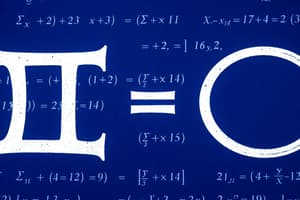Podcast
Questions and Answers
What does the symbol Σ represent in sigma notation?
What does the symbol Σ represent in sigma notation?
- The product of terms
- The difference of terms
- The sum of terms (correct)
- The ratio of terms
In the expression Σi=mn ai, what does 'i' represent?
In the expression Σi=mn ai, what does 'i' represent?
- The index of summation (correct)
- The lower limit
- The general term
- The upper limit
What happens to the index of summation as each term is calculated?
What happens to the index of summation as each term is calculated?
- It is multiplied by 2
- It decreases by 1
- It remains constant
- It increases by 1 (correct)
How do you calculate Σk=13 (k+2)?
How do you calculate Σk=13 (k+2)?
If Σi=15 2ai = 30, what would be the value of Σi=15 ai?
If Σi=15 2ai = 30, what would be the value of Σi=15 ai?
If Σi=mn ai = 10 and Σi=mn bi = 5, what would be the result of Σi=mn (ai + bi)?
If Σi=mn ai = 10 and Σi=mn bi = 5, what would be the result of Σi=mn (ai + bi)?
In the context of calculus, what is sigma notation primarily used for?
In the context of calculus, what is sigma notation primarily used for?
What is the result of Σi=33 (i * 4)?
What is the result of Σi=33 (i * 4)?
Flashcards
Sigma Notation
Sigma Notation
A concise way to express the sum of a series of terms using the Greek letter sigma (Σ).
Index of Summation (i)
Index of Summation (i)
The index of summation (i) takes on integer values from the lower limit (m) to the upper limit (n), representing the counter for each term.
Lower Limit of Summation (m)
Lower Limit of Summation (m)
The starting value for the index of summation (i).
Upper Limit of Summation (n)
Upper Limit of Summation (n)
Signup and view all the flashcards
General Term (ai)
General Term (ai)
Signup and view all the flashcards
Constant Factor Property
Constant Factor Property
Signup and view all the flashcards
Distributive Property
Distributive Property
Signup and view all the flashcards
Empty Sum Property
Empty Sum Property
Signup and view all the flashcards
Study Notes
Introduction to Sigma Notation
- Sigma notation, also known as summation notation, is a concise way to express the sum of a series of terms.
- It uses the Greek capital letter sigma (Σ) to represent the sum.
Components of Sigma Notation
- The general form of sigma notation is Σi=mn ai, where:
- Σ represents the summation.
- i is the index of summation (a counter variable).
- m is the lower limit of summation.
- n is the upper limit of summation.
- ai is the general term (formula or expression) to be summed.
Understanding the Index of Summation
- The index of summation (i) takes on integer values, starting from the lower limit (m) and ending at the upper limit (n).
- For each value of i, the corresponding term ai is calculated and added to the sum.
Example and Expansion
- Consider the expression Σi=14 i2.
- The index i starts at 1 and increases by 1 until it reaches 4.
- The terms to be summed are the squares of the index values.
- The expansion would be 12 + 22 + 32 + 42 = 1 + 4 + 9 + 16 = 30.
General Terms with Variables
- Sigma notation is applicable to any general term ai, which might include variables.
- For example: Σk=05 (2k + 1) calculates the sum of (2k + 1) for k = 0 to 5.
Properties of Sigma Notation
- Properties facilitate simplification and calculation of sums.
- Σi=mn c ai = c Σi=mn ai (c is a constant)
- Σi=mn (ai + bi) = Σi=mn ai + Σi=mn bi
- If the sum is from a starting index to the same index, it is 0.
Σi=mm ai = am.
Applications in Mathematics
- Sigma notation is used extensively in calculus, probability, statistics, and other areas of mathematics.
- In calculus, it's fundamental for defining integrals as limits of sums, for example, approximating areas under curves.
- In probability, sigma notation helps express probabilities over a range of values.
- In statistics, it expresses the calculation of statistical values like means and variances.
Uses in Programming
- In computer programming languages, looping structures (e.g., for loops) often translate directly into sigma notation sums.
- This facilitates efficient programming for calculations like sums over arrays.
Importance of Limits
- The lower and upper limits define the range of the index variable, which determines the terms to be summed.
- Correct limits are essential for getting the proper sum. Incorrect limits will give the wrong answer.
Handling Different Start Points
- While the standard form has a starting point of 1, sigma notation can use other lower limits of summation (e.g., m=0, m=2, etc.).
- Any integer for the lower limit is valid.
Infinite Sums
- One can sometimes have infinite sums, indicated by Σi=1∞ ai.
- These sums require special consideration for convergence, determining if the total value approaches a finite number.
Studying That Suits You
Use AI to generate personalized quizzes and flashcards to suit your learning preferences.




